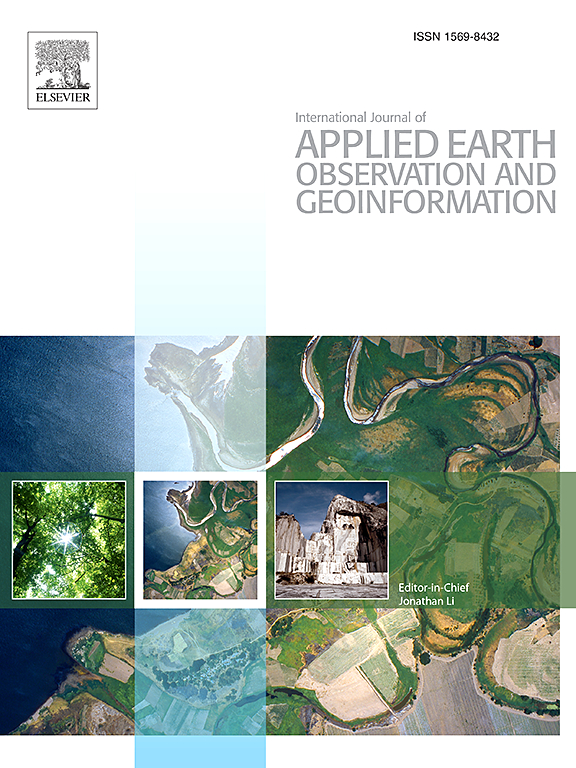莱索托农业生态区季节性和多年生地表水资源时空动态评估
IF 7.6
Q1 REMOTE SENSING
International journal of applied earth observation and geoinformation : ITC journal
Pub Date : 2025-06-25
DOI:10.1016/j.jag.2025.104688
引用次数: 0
摘要
地表水资源对农业生产力和农村生计至关重要,特别是在撒哈拉以南非洲等缺水地区。在莱索托,了解季节性和多年生水体的动态对于知情的水资源管理和政策制定至关重要。本文对2016 - 2024水年莱索托不同农业生态区地表水时空动态的光谱指数进行了评价。将统一的Sentinel图像集成到随机森林机器学习框架中,我们应用一系列水、植被和土壤指数来绘制地表水月度图,并区分季节性和多年生水面。我们的研究结果表明,水比指数是绘制经济特区地表水地图最有效的方法,在区分牧场、农田和裸地的水方面优于其他方法。其他指标进一步改善了特定专属经济区的水圈定。尽管不同aez的分类准确率没有显著差异(p >;0.05),目测分类错误,以假阳性为主,可能导致水域面积高估。地表水的变化趋势因区域而异,丘陵和山区的常年水量显著增加,而季节性水量则呈现不显著的下降,表明水文轨迹不同。这些发现强调需要针对具体区域的评估和管理战略,以应对不断变化的水文制度。我们的研究提供了一个可扩展的水资源评估框架,适用于莱索托以外的地区,对解决水资源短缺问题以及指导撒哈拉以南非洲地区的水资源储存、气候智能型农业和社区治理政策具有重要意义。本文章由计算机程序翻译,如有差异,请以英文原文为准。
Assessing the spatiotemporal dynamics of seasonal and perennial surface water resources across Lesotho’s agroecological zones
Surface water resources are crucial for agricultural productivity and rural livelihoods, particularly in water-scarce regions such as Sub-Saharan Africa. In Lesotho, understanding the dynamics of seasonal and perennial water bodies is vital for informed water resource management and policy development. This study evaluates spectral indices for mapping and analyzing the spatiotemporal dynamics of surface water across different agroecological zones (AEZs) in Lesotho from 2016 to 2024 water years. Using harmonized Sentinel imagery integrated into a Random Forest machine-learning framework, we applied a range of water, vegetation, and soil indices to map surface water monthly and distinguish between seasonal and perennial water surfaces. Our findings reveal that the water ratio index was the most effective for mapping surface water across AEZs, outperforming others in distinguishing water from rangeland, cropland, and bare soil. Additional indices further improved water delineation in specific AEZs. Although no significant differences in classification accuracy were observed across AEZs (p > 0.05), visual inspection revealed misclassifications, mainly false positives, which could lead to overestimates of water area. Surface water trends vary regionally, with a significant increase in perennial water in the Foothills and Mountains, while seasonal water shows a non-significant decline, indicating divergent hydrological trajectories. These findings underscore the need for region-specific assessments and management strategies to address the evolving hydrological regimes. Our study provides a scalable framework for water resource assessment applicable beyond Lesotho, with significant implications for addressing water scarcity and guiding policies on water storage, climate-smart agriculture, and community-based governance in Sub-Saharan Africa.
求助全文
通过发布文献求助,成功后即可免费获取论文全文。
去求助
来源期刊

International journal of applied earth observation and geoinformation : ITC journal
Global and Planetary Change, Management, Monitoring, Policy and Law, Earth-Surface Processes, Computers in Earth Sciences
CiteScore
12.00
自引率
0.00%
发文量
0
审稿时长
77 days
期刊介绍:
The International Journal of Applied Earth Observation and Geoinformation publishes original papers that utilize earth observation data for natural resource and environmental inventory and management. These data primarily originate from remote sensing platforms, including satellites and aircraft, supplemented by surface and subsurface measurements. Addressing natural resources such as forests, agricultural land, soils, and water, as well as environmental concerns like biodiversity, land degradation, and hazards, the journal explores conceptual and data-driven approaches. It covers geoinformation themes like capturing, databasing, visualization, interpretation, data quality, and spatial uncertainty.
 求助内容:
求助内容: 应助结果提醒方式:
应助结果提醒方式:


